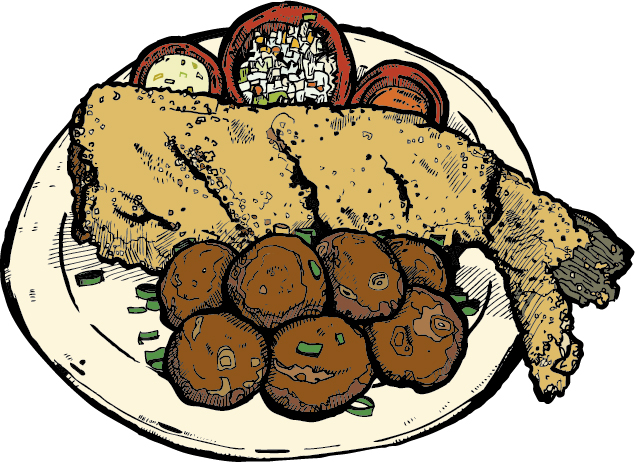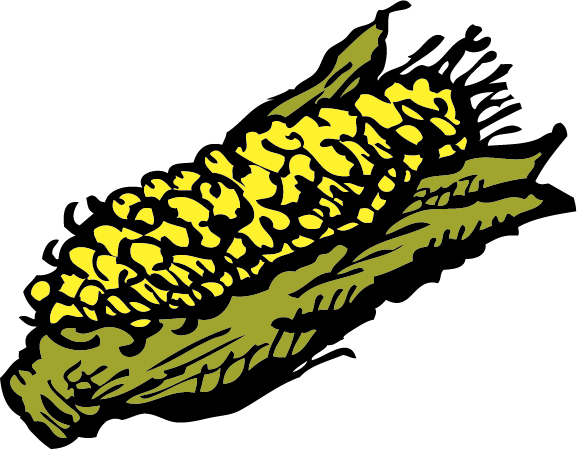TIME TO EAT! African American Dinner menu pt. 1

A Fundraiser for the African American Cultural & Historical Museum of Washtenaw County
The 9th Annual African American Foodways Dinner is happening this coming Tuesday, January 14 at 7pm at Zingerman’s Roadhouse. Here, Ari talks about the menu choices for the dinner, and their history within the African American cooking lexicon.
In making the menu for our 9th annual African American Foodways dinner, a fundraiser for the African American Cultural & Historical Museum of Washtenaw County, we’re serving some classics of African American cooking. While every family will of course have their twists on tradition, this list is a pretty solid collection of well-known and much loved dishes. As Deborah Meadows, one of the women whose hard work has made the museum a reality, said when we reviewed it together, “The menu is a feast! Yum!”
Below are brief descriptions of the dishes along with a bit of history and how they came to be such a big part of African American eating. Much of the historical information came from Adrian Miller’s highly recommended book, Soul Food: The Surprising Story of an American Cuisine. If you enjoy the meal at the Museum fundraiser, you’ll probably want to join us again April. Adrian will be joining us for a special dinner based on his book. We’re excited to have him back—he’s already been a huge hit at two of our nine African American dinners—one on the theme of African Americans in the White House (which coincidentally took place right around President Obama’s first inauguration) and the other on this same theme of Soul Food.
The Menu!
Fried Chicken

No one seems 100% sure how fried chicken came to hold such an honored place on the African American table, but it pretty clearly has for well over a hundred years now. Chickens probably came to Africa from Asia in about 1000AD. Birds had long been prominent in West African religious lore and local elites took to them quickly. Chickens were often thought to be holy and came to be used for religious sacrifice.
As with so many foods, it was a dish that was used by whites to stereotype African Americans. But the reality is that southern whites seem to have eaten it with great regularity as well. In his research, Adrian Miller discovered that fried chicken was first written up as a recipe in Hannah Glasse’s 1747 book, The Art of Cookery Made Plain and Easy. Glasse features a recipe for fried chicken that would likely have won praise in the homes of well-to-do white plantation owners. Seventy or so years later, in 1824, Mary Randolph’s now classic book, The Virginia Housewife, published an iconic recipe in which the chicken is fried in lard and butter, adding a bit of smoked pork to the fat for additional flavor (as Adrian says, she “doubled down on pork”). A third version, “Maryland-style” fried chicken, became quite popular along the Chesapeake. It was first battered, and then shallow-fat-fried and was typically served with gravy, waffles or corn fritters. Adrian writes that the famous “chicken and waffles” probably had its roots in the early 19th century where fried chicken and some sort of quick bread were quite commonly paired and called a “Virginia breakfast.”
At the Zingerman’s Roadhouse we use chickens from Amish farmers about half an hour west of here in Homer, MI and prepare them in a style that Chef Alex and crew have adapted from the very famous Gus’ Fried Chicken just outside of Memphis. Seasoned with a good bit of black and red pepper and then dipped in buttermilk batter before frying. Over the years it’s become our biggest selling menu item at the Roadhouse.
Fried Catfish
 In Soul Food, Adrian Miller shows that West Africans have been big fish eaters since medieval times. Enslaved Africans would likely have embraced catfish as one of the foods that still seemed familiar. In the American South, fish provided a low-cost way to feed slaves. West Africans have long had a very positive attitude towards
fish. Not shockingly, we have a few West African customers who order catfish religiously at the Roadhouse, and catfish
has become one of our most popular dishes. The fish come from
Yazoo City, Mississippi (in the ‘60s farmers in the Delta started switching
from cotton to catfish). Aquaculture made catfish available year round, adding to its popularity. Here at the Roadhouse we roll each fish in the organic yellow cornmeal we get from Anson Mills down in South Carolina — a blend of four different heirloom corn varietals (two dating to the 17th century and two more to the 18th), and then deep fry it ‘til it turns golden brown. Served with white grits from Anson Mills (a different heirloom corn varietal, this one from the 19th century) and collard greens. Fish and grits, if you’ve never tried it, is a terrific combination! A guest from South Carolina told me at the Roadhouse last night that it “the best catfish I’ve ever had. And I’ve had a lot of catfish!”
In Soul Food, Adrian Miller shows that West Africans have been big fish eaters since medieval times. Enslaved Africans would likely have embraced catfish as one of the foods that still seemed familiar. In the American South, fish provided a low-cost way to feed slaves. West Africans have long had a very positive attitude towards
fish. Not shockingly, we have a few West African customers who order catfish religiously at the Roadhouse, and catfish
has become one of our most popular dishes. The fish come from
Yazoo City, Mississippi (in the ‘60s farmers in the Delta started switching
from cotton to catfish). Aquaculture made catfish available year round, adding to its popularity. Here at the Roadhouse we roll each fish in the organic yellow cornmeal we get from Anson Mills down in South Carolina — a blend of four different heirloom corn varietals (two dating to the 17th century and two more to the 18th), and then deep fry it ‘til it turns golden brown. Served with white grits from Anson Mills (a different heirloom corn varietal, this one from the 19th century) and collard greens. Fish and grits, if you’ve never tried it, is a terrific combination! A guest from South Carolina told me at the Roadhouse last night that it “the best catfish I’ve ever had. And I’ve had a lot of catfish!”
Pork Barbecue

We’ve been making Eastern North Carolina-style barbecue at the Roadhouse since we opened in 2003. We were trained by our mentor, African American pit master, Mr. Ed Mitchell of Raleigh, North Carolina. “Culturally,” Mr. Mitchell told me a while back, “barbecue was started by black folks. During the era of slavery, they made barbecue for white people, and then they were given the innards and undesirable cuts. That’s why they got used to cooking all those cuts.” As you might have guessed from the fact that we chose to model our barbecue after Mr. Mitchell’s (after tasting a lot of other versions), his is very, very good. “My point,” he added, “is that it was a necessity for them to survive.”
For Roadhouse barbecue we use free-running, antibiotic-free, heirloom breed hogs (which have far more fat, and much more flavor than the commercial hogs most folks are using). We smoke them on the pit (that Mr. Mitchell helped us build) over oak logs for a good 14 or 15 hours. We pull the tender meat from the bones, give it a coarse chop and then dress it with a traditional Eastern Carolina vinegar sauce. For the latter, we use the very excellent two-year-old, barrel-aged organic cider vinegar that we get from Pierre Gingras up in Quebec which we then season with a touch of Muscovado brown sugar, sea salt and Telicherry black pepper. I think it’s got it all. Flavor, texture, history, a good story, a great finish. Smoky warm pork, dressed in that tangy cider vinegar sauce.
Grits
 Corn has been eaten in West Africa since
the 16th century when it was introduced by
the Portuguese. In the Americas, whites and
enslaved Africans would have learned how
to grow, cure, and cook corn from Native
Americans. African Americans probably
ate much more of it. European whites
preferred wheat and left cornmeal, grits,
mush, and cornbread for their slaves. Grits
have long been a staple of African American
cooking. Adrian Miller quotes a South Carolina planter: “The subsistence of slaves consists, from March until August, of corn ground into grits, or meal, made into what is call hominy or baked into cornbread.”
Corn has been eaten in West Africa since
the 16th century when it was introduced by
the Portuguese. In the Americas, whites and
enslaved Africans would have learned how
to grow, cure, and cook corn from Native
Americans. African Americans probably
ate much more of it. European whites
preferred wheat and left cornmeal, grits,
mush, and cornbread for their slaves. Grits
have long been a staple of African American
cooking. Adrian Miller quotes a South Carolina planter: “The subsistence of slaves consists, from March until August, of corn ground into grits, or meal, made into what is call hominy or baked into cornbread.”
Adrian quotes an abolitionist periodical from 1839, which says that, “the corn furnished to the slaves at the south, is almost invariably the white gourd seed corn.” And, as it happens, what we’ve served since day one at the Roadhouse is exactly that — white grits from a gourd seed variety from Anson Mills, where Glenn Roberts and crew craft some of the best old-school dried corn grown and milled anywhere in the country. They work only with heirloom seed varieties (much lower yield, much bigger flavor); all are grown organically and field-ripened to develop their full flavor; all are cold stone-milled (chilled below 32°F so that they never go above 40°F during the milling); and have their germ (i.e., the natural oil) left in which adds great flavor, but makes the milled corn a perishable product. Grits like this are what African Americans in the South before the years of the Great Migration would have likely referred to as “fresh grits” or “country grits.” They’re enormously flavorful—the difference between these and what one cooks from the supermarket varieties is night and day.




Zingerman’s Art for Sale